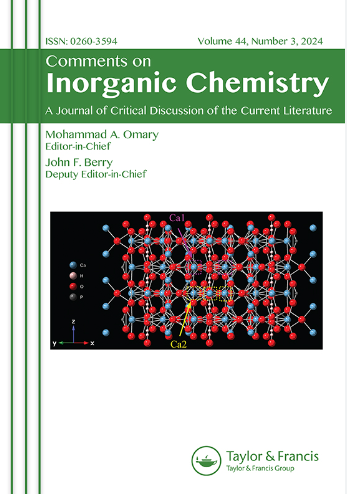水溶液中钆(III) -柠檬酸体系络合物形成的新进展
IF 3.8
3区 化学
Q1 CHEMISTRY, INORGANIC & NUCLEAR
引用次数: 1
摘要
摘要:采用pH滴定法、质子磁弛豫法和数学模拟研究了钆(III)与柠檬酸在pH为2.0 ~ 10、[Gd3+]: [H4Cit] = 1:1、1:2、1:3 ([Gd3+] = 1.3、2.6、5.0、10.0和20.0 mmol L−1)水溶液中的络合反应。在模拟过程中,以平衡组成为基础,该平衡组成是由先前已知的工作获得的模型,包括钆(III)的单柠檬酸盐和双柠檬酸盐配合物。在这项工作中,表明只有额外包含具有较高质子化程度的钆(III)的柠檬酸配合物和一些新的多核配合物,才能实现对两种独立的物理化学方法的实验数据集的满意描述。首次以1:1的摩尔比检测到具有柠檬酸配体分子形态的配合物[GdH4Cit]3+和多核配合物[Gd2(HCit)2]°、[Gd2Cit2]2-、[Gd6(OH)2Cit6]8-、[Gd6(OH)3Cit6]9-。在柠檬酸过量2倍和3倍的情况下,发现了具有不同程度质子化的单核双柠檬酸和三柠檬酸配合物,以及pH为bbb7.5的双核四核和六核柠檬酸配合物[Gd2(HCit)Cit3]9和[Gd2(HCit)4Cit2]14-。在这个手稿的例子上,应用核磁共振弛豫方法在含有顺磁离子的系统中识别多核络合的重要性被显示出来。图形抽象本文章由计算机程序翻译,如有差异,请以英文原文为准。
New Aspects of Complex Formation in the Gadolinium(III)–Citric Acid System in Aqueous Solution
ABSTRACT The complexation of gadolinium(III) with citric acid in aqueous solutions was studied by pH-metric titration, proton magnetic relaxation, and mathematic simulation in the pH range 2.0–10 at [Gd3+]: [H4Cit] = 1:1, 1:2, 1:3 ([Gd3+] = 1.3, 2.6, 5.0, 10.0, and 20.0 mmol L−1). In the process of simulation, the equilibrium composition, a model obtained from previously known works and including mono- and bis-citrate complexes of gadolinium(III) was taken as a basis. In this work, it is shown that a satisfactory description of the experimental data set of two independent physico-chemical methods is achieved only with the additional inclusion of citrate complexes of gadolinium(III) with higher degree of protonation and some new polynuclear complexes. The complex [GdH4Cit]3+ with the molecular form of the citrate ligand, and the polynuclear complexes [Gd2(HCit)2]°, [Gd2Cit2]2-, [Gd6(OH)2Cit6]8-, [Gd6(OH)3Cit6]9- were first detected at the molar ratio of 1:1. At two- and three-fold excess of citric acid, mononuclear bis- and tris-citrate complexes with different degrees of protonation were found, and binuclear tetrakis- and hexakis-citrate complexes [Gd2(HCit)Cit3]9-and [Gd2(HCit)4Cit2]14- at the pH > 7.5. On the example of this manuscript, the importance of applying the NMR relaxation method for identifying polynuclear complexation in systems containing paramagnetic ions is shown. GRAPHICAL ABSTRACT
求助全文
通过发布文献求助,成功后即可免费获取论文全文。
去求助
来源期刊

Comments on Inorganic Chemistry
化学-无机化学与核化学
CiteScore
9.00
自引率
1.90%
发文量
18
审稿时长
>12 weeks
期刊介绍:
Comments on Inorganic Chemistry is intended as a vehicle for authoritatively written critical discussions of inorganic chemistry research. We publish focused articles of any length that critique or comment upon new concepts, or which introduce new interpretations or developments of long-standing concepts. “Comments” may contain critical discussions of previously published work, or original research that critiques existing concepts or introduces novel concepts.
Through the medium of “comments,” the Editors encourage authors in any area of inorganic chemistry - synthesis, structure, spectroscopy, kinetics and mechanisms, theory - to write about their interests in a manner that is both personal and pedagogical. Comments is an excellent platform for younger inorganic chemists whose research is not yet widely known to describe their work, and add to the spectrum of Comments’ author profiles, which includes many well-established inorganic chemists.
 求助内容:
求助内容: 应助结果提醒方式:
应助结果提醒方式:


